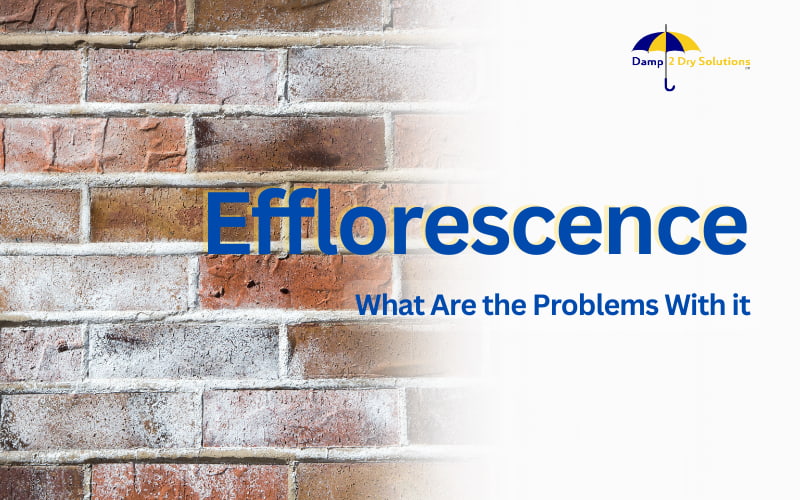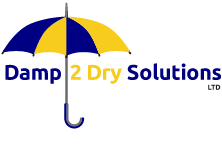
Efflorescence might sound like a fancy French word, but if you’ve spotted those pesky white powdery deposits on your walls, you’re likely dealing with an issue that could spell trouble for your property. While it might not be a cause for immediate panic, it’s certainly not something you should ignore.
In this efflorescence guide, we’ll dive into what efflorescence is, how it occurs, the problems it can cause, and what you can do about it.
Efflorescence Problems in Brief
- Efflorescence in bricks or stone is that white, powdery residue caused by moisture drawing salts to the surface.
- It signals hidden damp issues — so while the deposit itself isn’t harmful, ask yourself: “Is efflorescence a serious problem?” Yes, if you leave it unchecked, because it points to ongoing moisture ingress.
- Common risks include aesthetic staining, weakened mortar, and eventually damp or mould inside your home.
- DIY fixes like scrubbing, pressure washing, or sealants can help with how to get rid of efflorescence, but long-term control means treating the moisture source.
- Professional damp surveys target salt efflorescence at its root, ensuring repairs and proofing prevent it from returning.
What Is Efflorescence?
Efflorescence is a term used to describe those white, chalky deposits that sometimes appear on brick, stone, or cement surfaces. This phenomenon occurs when water moves through porous building materials, bringing along soluble salts. As the water evaporates, it leaves behind these unsightly salt deposits on the surface.
is efflorescence a sign of damp? Yes, efflorescence is often a sign of dampness. It occurs when moisture in walls brings salts to the surface, leaving a white, powdery residue. This typically indicates that there is moisture within the wall, which could be a sign of damp in the bricks.
How Does It Occur?
Efflorescence happens due to the movement of water through materials like brick, concrete, or stone, which are naturally porous. When water enters these materials, it dissolves salts within them. As the water reaches the surface and evaporates, the salts are left behind, creating that characteristic white powder.
Several factors can contribute to the occurrence of efflorescence:
- Excess Moisture: Whether from rain, leaks, or high humidity, water is the key culprit behind efflorescence.
- Salts in Materials: The salts that cause efflorescence are present in construction materials like bricks and mortar.
- Poor Building Practices: Improper storage of materials, insufficient damp proofing, or inadequate ventilation can all lead to moisture ingress and, subsequently, efflorescence.
Is Efflorescence Harmful?
On its own, efflorescence isn’t dangerous to your health. It won’t harm you directly, but that doesn’t mean it’s harmless. The presence of efflorescence is often a symptom of a more significant issue—excess moisture in your walls. Over time, this moisture can lead to structural damage, decay, and even mould growth, which can pose health risks.
How to Spot Efflorescence?
Spotting efflorescence is relatively easy because of its distinct appearance:
- White or Greyish Powder: Efflorescence looks like a white or sometimes greyish powder on the surface of bricks, cement, or stone.
- Rubbing Test: If you rub the affected area with your fingers, the powder will come off easily.
- Water Solubility: Efflorescence dissolves when exposed to water, unlike mould or other stains, which may persist.
It’s crucial to distinguish efflorescence from other issues like mould or staining because the treatment and implications can differ significantly. Don’t get confused by mould. Here’s your guide to identifying mould and its colours.
What Are Efflorescence Problems? Should I Worry About Efflorescence?
Efflorescence itself isn’t the main problem; it’s more of a red flag that indicates underlying moisture issues. Ignoring efflorescence can lead to more severe problems down the line:
- Structural Damage: Continuous moisture ingress can weaken brickwork, mortar, and even the foundations of your property.
- Aesthetic Damage: Efflorescence can ruin the appearance of your walls, both inside and outside, making your property look unkempt.
- Damp and Mould: Moisture that causes efflorescence can also lead to damp issues, resulting in the growth of black mould, which can be harmful to your health.
So, should you worry? If you spot efflorescence, it’s a sign that something isn’t right with your property’s moisture levels. It’s worth looking into and addressing sooner rather than later to prevent more severe issues.
Can Efflorescence Damage Your Foundation?
While efflorescence itself won’t directly damage your foundation, it’s a warning sign that water is present where it shouldn’t be. Over time, moisture can penetrate deeper into your property, potentially compromising the structural integrity of your foundation. If left unchecked, this could lead to serious, costly repairs.
Common Places To See Efflorescence
Efflorescence can appear almost anywhere on your property, but some areas are more prone to it:
- Exterior Brick Walls: Particularly after a wet season, you might notice efflorescence on your exterior walls.
- Basements: Basements are prime locations for efflorescence due to their proximity to the ground and potential for high humidity.
- Interior Walls: If you have exposed brickwork inside, efflorescence can make an appearance, especially if there’s a damp issue.
How To Remove Efflorescence?

If efflorescence has already appeared on your property, the good news is that it can be removed. Here’s how you can deal with efflorescence inside the house or on your brick wall.
Scrubbing
For minor cases, a simple scrub with a stiff brush can do the trick. Make sure the wall is dry before you start, and brush away the powdery deposits. This method is effective for small areas but might not be suitable for extensive cases.
Chemical Cleaners
For more stubborn efflorescence, you might need to use a chemical cleaner. Products designed for efflorescence removal can break down the salt deposits and make them easier to wash away. Always follow the manufacturer’s instructions and wear appropriate protective gear.
Pressure Washing
If efflorescence has taken over a large area, pressure washing can be an effective method. A high-pressure wash can remove the salts quickly, but be cautious—using too much pressure can damage the surface. After washing, ensure the area dries thoroughly to prevent moisture from seeping back in.
Sealing
Once you’ve removed the efflorescence, it’s a good idea to seal the affected area to prevent future occurrences. Applying a hydrophobic sealant can help keep moisture out, reducing the likelihood of efflorescence returning. For brick, a silicone-based penetrating sealer works best, while elastomeric or polyurethane sealers are ideal for cement blocks.
How Damp 2 Dry Solutions Can Help
Dealing with efflorescence can be a hassle, but you don’t have to tackle it alone. At Damp 2 Dry Solutions, we specialise in identifying and resolving damp-related issues, including efflorescence. Our expert team can provide a thorough survey of your property, pinpointing the root cause of moisture ingress and offering tailored solutions to fix the problem.
Whether you’re dealing with rising damp, penetrating damp, or any other moisture-related issue, we’re here to assist. Our services include professional damp proofing, foundation repairs, and efflorescence treatment, ensuring your property stays dry, strong, and visually appealing.
Get in touch with us today to schedule a survey and take the first step towards a damp-free, efflorescence-free home.
In a nutshell
While efflorescence might seem like a minor cosmetic issue, it’s often a sign of more significant underlying problems. By understanding what causes efflorescence, recognising the risks, and knowing how to address it, you can protect your property from potential damage.
Don’t ignore the warning signs—take action today to keep your home in top condition.

